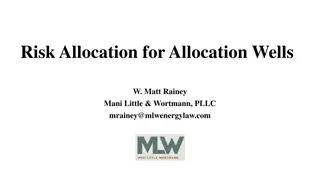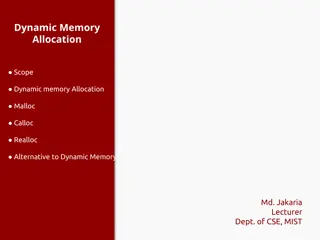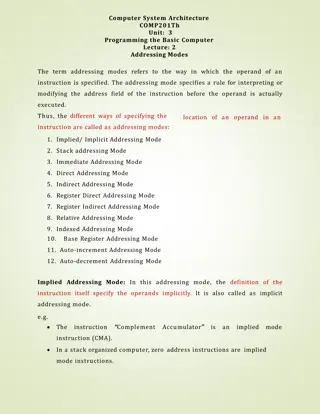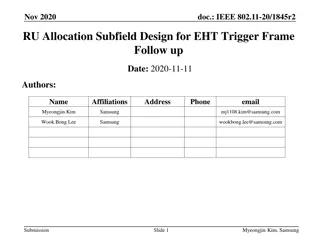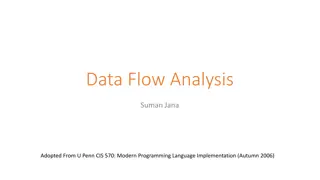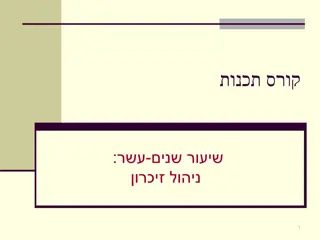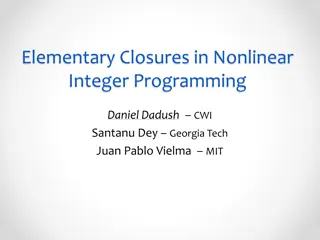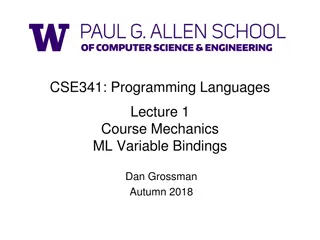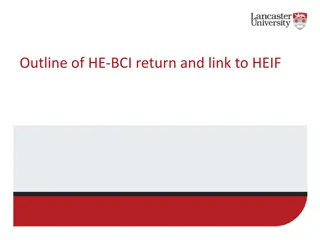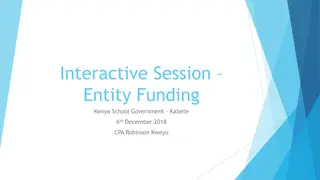Programming Practice and Register Allocation
This review covers various programming problems, live ranges of variables X, Y, and Z, interference graph analysis, and register allocation strategies using registers R1, R2, and R3. It delves into code snippets, control flow structures, and optimization techniques for better code generation.
Download Presentation

Please find below an Image/Link to download the presentation.
The content on the website is provided AS IS for your information and personal use only. It may not be sold, licensed, or shared on other websites without obtaining consent from the author. Download presentation by click this link. If you encounter any issues during the download, it is possible that the publisher has removed the file from their server.
E N D
Presentation Transcript
1. Input X 2. Input Y 3. X=X+Y 1. Input X 2. Input Y 3. X=X+Y 4. If Z<0 go to 7 5. X=X+1 6. Go to 8 7. X=X-1 8. Y=Y+1 9. T=X+Y 10. If Z==T go to 4 11. Output Z 4. If Z<0 go to 7 f t 5. X=X+1 6. Go to 8 7. X=X-1 8. Y=Y+1 9. T=X+Y 10. If Z==T go to 4 t f 11. Output Z
Input X Input X Input Y Input Y If X<Y go to L1 Z=X+Y X=Y Go to L2 L1: Z=X-Y X=Y L2: Output X Output Y Output Z If X<Y go to L1 f t Z=X+Y L1: Z=X-Y X=Y X=Y Go to L2 L2: Output X Output Y Output Z
IN[1] = { } 1 Input X GEN[1] = { } KILL[1] = {X,Y} Input Y If X<Y go to L1 OUT[1] = {X,Y} f t IN[3] = {X,Y} IN[2] = {X,Y} Z=X+Y 2 3 L1: Z=X-Y GEN[3] = {X,Y} KILL[3] = {X,Z} GEN[2] = {X,Y} KILL[2] = {X,Z} X=Y X=Y Go to L2 OUT[2] = {X,Y,Z} OUT[3] = {X,Y,Z} IN[4] = {X,Y,Z} 4 L2: Output X GEN[4] = {X,Y,Z} KILL[4] = { } Output Y Output Z OUT[4] = { }
LIVE RANGES OF X, Y and Z Input X Input X Input X Input Y Input Y Input Y If X<Y go to L1 If X<Y go to L1 If X<Y go to L1 Z=X+Y Z=X+Y Z=X+Y L1: Z=X-Y L1: Z=X-Y L1: Z=X-Y X=Y X=Y X=Y X=Y X=Y X=Y Go to L2 Go to L2 Go to L2 L2: Output X L2: Output X L2: Output X Output Y Output Y Output Y Output Z Output Z Output Z
LIVE RANGES OF X, Y and Z X1 Y X2 Z
INTERFERENCE GRAPH X1 Y X1 Y X2 Z X2 Z
REGISTER ALLOCATION: R1, R2, R3 X1 REMOVE DEGREE<3 X1, X2, Z; Y Y COLOR IN REVERSE ORDER Y R1 Z R2 X2 R3 X1 R2 or R3 X2 Z
REGISTER ALLOCATION: R1, R2 X1 REMOVE DEGREE<2 X1; spill Y; X2, Z Y COLOR IN REVERSE ORDER Z R1 X2 R2 X1 R1 or R2 X2 Z
Main F G H F c-d 1-1 2-1 0 3-1 2-2 1 Control Links Access Links 0:a 1:b Main 2 0:a 1:c 1 F 2 0:a 1:e G 3 0:a 1:d H Access b in H traverse 3-1=2 links then at offset at of 1 find b 2 0:a 1:c F 1
GRAMMAR RELEVANT PRODUCTIONS CONSTRUCT if x < y then <otherstatements> elseif a > b then <otherstatements> elseif c == d then <otherstatements> else <otherstatements> endif <S> if <condt> then <otherstatements> <rest> <rest> elseif <condt> then <otherstatements> <rest> | else <otherstatements> endif <condt> id relop id Question: Provide SEMANTIC RULES that generate code and finally place it in attribute <S>.code
INTERMEDIATE CODE if x < y go to L1 CONSTRUCT go to L2 L1: <otherstatements> if x < y then go to exitL <otherstatements> L2: If a > b go to L3 elseif a > b then go to L4 <otherstatements> L3: <otherstatements> elseif c == d then go to exitL <otherstatements> L4: if c==d go to L5 else go to L6 <otherstatements> L5: <otherstatements> endif go to exitL L6: <otherstatements> exitL: .
<S> if <condt> then <otherstatements> <rest> id relop id elseif <condt> then <otherstatements> <rest> id relop id elseif <condt> then <otherstatements> <rest> id relop id else <otherstatements> endif
<S> <condt>.falselabel <condt>.code if <condt> then <otherstatements> <rest> <rest>.ifalselabel <rest>.iexit <rest>.icode <rest>.scode <S>.code id relop id elseif <condt> then <otherstatements> <rest> id relop id elseif <condt> then <otherstatements> <rest> id relop id else <otherstatements> endif if x < y go to L1 L6: <otherstatements> L2: If a > b go to L3 L4: if c==d go to L5 go to L2 exitL: . go to L4 go to L6 L1: <otherstatements> L3: <otherstatements> L5: <otherstatements> go to exitL go to exitL go to exitL L2: <rest> L4: <rest> L6: <rest>
<S>.code = rcbcgcpc <rest>.scode = rcbcgcpc <condt>.falselabel = L2 <condt>.code = . <rest>.ifalselabel = L2 <rest>.iexit = exitL <rest>.icode = rc <rest>.scode = rcbcgcpc <condt>.falselabel = L4 <condt>.code = . <rest>.ifalselabel = L4 <rest>.iexit = exitL <rest>.icode = rcbc <condt>.falselabel = L6 <condt>.code = . <rest>.ifalselabel = L6 <rest>.iexit = exitL <rest>.icode = rcbcgc <rest>.scode = rcbcgcpc if x < y go to L1 L6: <otherstatements> L2: If a > b go to L3 L4: if c==d go to L5 go to L2 exitL: . go to L4 go to L6 L1: <otherstatements> L3: <otherstatements> L5: <otherstatements> go to exitL go to exitL go to exitL L2: <rest> L4: <rest> L6: <rest>









